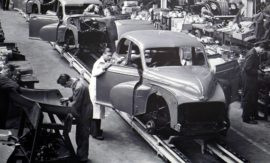Intended learning outcomes: Present an excerpt from the parameterized bill of material for the fire damper.
Figure 7.3.3.1 shows an excerpt from the product structure of the fire damper in Figure 7.3.1.1. This part of the bill of material lists some attributes and if-clauses important to an understanding of production rules.
Fig. 7.3.3.1 Excerpt from the parameterized bill of material for the fire damper.
For the query, the facts — the product identifiers, order quantity, and all parameter values — have been added. Through comparison of these facts with the rules stored for the product family, program logic determines for each position the first variant of the bill of material or routing sheet for which evaluation of the rule results in the value “true.”
Try the following exercise: In Figure 7.3.3.1, what variants are selected, given the following parameter values: Type = 1, drive = left, width = 400, height = 120?
Solution: Position/variant: 130/01, 150/01, 155/01, 160/01. Also compare the exercise in Section 7.8 (Scenarios and Exercises).
Continuation in next subsection (7.3.3b).
Course section 7.3: Subsections and their intended learning outcomes

7.3 Generative Techniques
Intended learning outcomes: Disclose the combinatorial aspect and the problem of redundant data. Present variants in bills of material and routing sheets as production rules of a knowledge-based system. Explain the use of production rules in order processing.

7.3.1 The Combinatorial Aspect and the Problem of Redundant Data
Intended learning outcomes: Present setting the parameters of the fire damper. Disclose the number of possible combinations with n parameters as well as an example for number of identical bill-of-material positions.

7.3.2 Variants in Bills of Material and Routing Sheets: Production Rules of a Knowledge-Based System
Intended learning outcomes: Differentiate between design rules and process rules. Explain the concept of design rules or process rules.

7.3.3 The Use of Production Rules in Order Processing: The Parameterized Bill of Material
Intended learning outcomes: Present an excerpt from the parameterized bill of material for the fire damper.

7.3.3b The Maximum Bill of Material and the Maximum Routing Sheet
Intended learning outcomes: Present the maximum bill of material and maximum routing sheet. Identify data storage complexity for the fire damper example. Disclose the use of generative techniques in connection with CAD and CAM as well as in the service industries.
